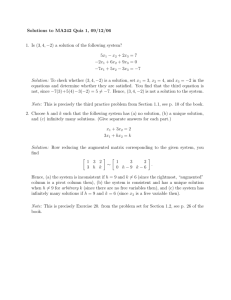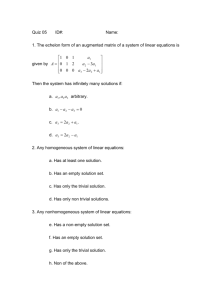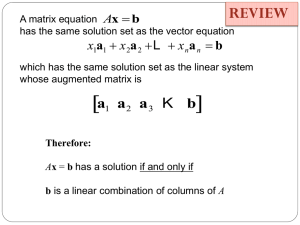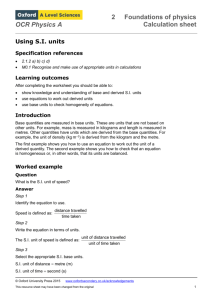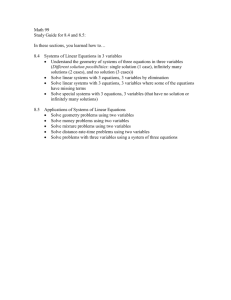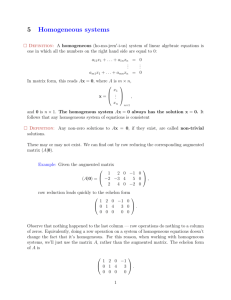Solution Set
advertisement
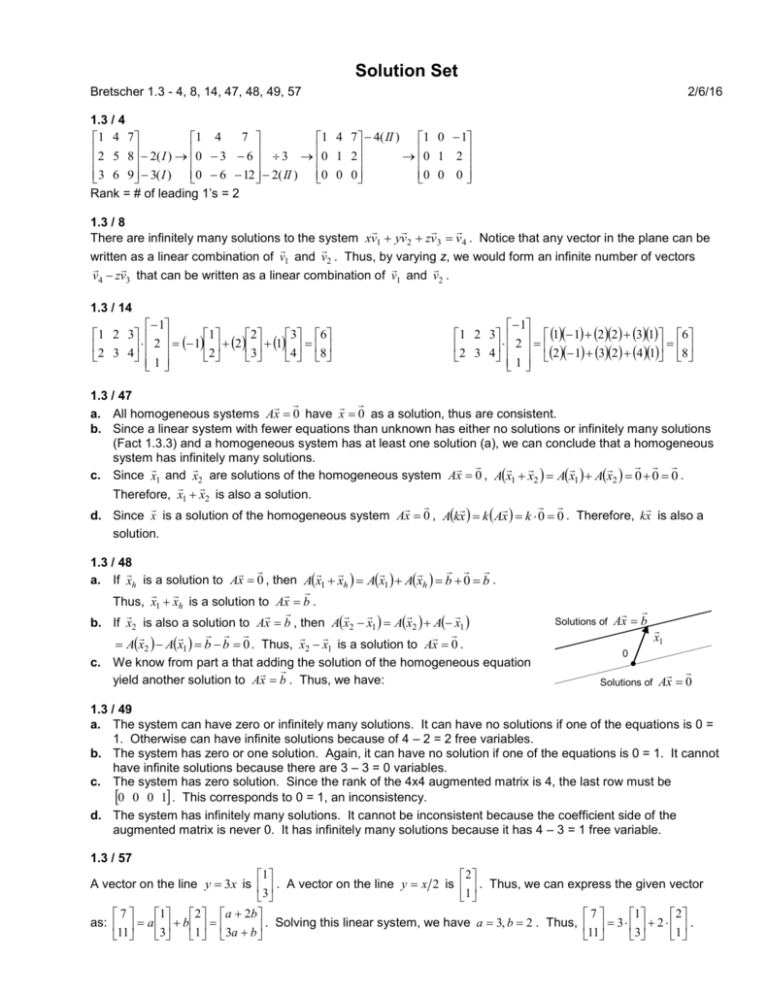
Solution Set Bretscher 1.3 - 4, 8, 14, 47, 48, 49, 57 2/6/16 1.3 / 4 7 1 4 7 1 4 1 4 7 4( II ) 1 0 1 2 5 8 2( I ) 0 3 6 3 0 1 2 0 1 2 3 6 9 3( I ) 0 6 12 2( II ) 0 0 0 0 0 0 Rank = # of leading 1’s = 2 1.3 / 8 There are infinitely many solutions to the system xv1 yv2 zv3 v4 . Notice that any vector in the plane can be written as a linear combination of v1 and v2 . Thus, by varying z, we would form an infinite number of vectors v4 zv3 that can be written as a linear combination of v1 and v2 . 1.3 / 14 1 1 2 3 1 2 3 6 2 3 4 2 12 23 14 8 1 1 1 2 3 1 1 22 31 6 2 3 4 2 2 1 32 41 8 1 1.3 / 47 a. All homogeneous systems Ax 0 have x 0 as a solution, thus are consistent. b. Since a linear system with fewer equations than unknown has either no solutions or infinitely many solutions (Fact 1.3.3) and a homogeneous system has at least one solution (a), we can conclude that a homogeneous system has infinitely many solutions. c. Since x1 and x2 are solutions of the homogeneous system Ax 0 , Ax1 x2 Ax1 Ax2 0 0 0 . Therefore, x1 x2 is also a solution. d. Since x is a solution of the homogeneous system Ax 0 , Akx k Ax k 0 0 . Therefore, kx is also a solution. 1.3 / 48 a. If xh is a solution to Ax 0 , then Ax1 xh Ax1 Axh b 0 b . Thus, x1 xh is a solution to Ax b . b. If x2 is also a solution to Ax b , then Ax2 x1 Ax2 A x1 Ax2 Ax1 b b 0 . Thus, x2 x1 is a solution to Ax 0 . c. We know from part a that adding the solution of the homogeneous equation yield another solution to Ax b . Thus, we have: Solutions of Ax b x1 0 Solutions of Ax 0 1.3 / 49 a. The system can have zero or infinitely many solutions. It can have no solutions if one of the equations is 0 = 1. Otherwise can have infinite solutions because of 4 – 2 = 2 free variables. b. The system has zero or one solution. Again, it can have no solution if one of the equations is 0 = 1. It cannot have infinite solutions because there are 3 – 3 = 0 variables. c. The system has zero solution. Since the rank of the 4x4 augmented matrix is 4, the last row must be 0 0 0 1 . This corresponds to 0 = 1, an inconsistency. d. The system has infinitely many solutions. It cannot be inconsistent because the coefficient side of the augmented matrix is never 0. It has infinitely many solutions because it has 4 – 3 = 1 free variable. 1.3 / 57 1 2 A vector on the line y 3x is . A vector on the line y x 2 is . Thus, we can express the given vector 3 1 7 1 2 a 2b 7 1 2 as: a b . Solving this linear system, we have a 3, b 2 . Thus, 3 2 . 11 3 1 3a b 11 3 1
